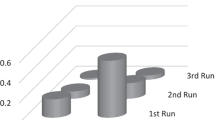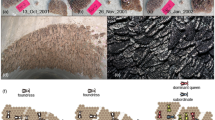Summary
Incidents of usurpation were observed in colonies of Polistes fuscatus nesting on farm buildings (1977–79) and in nestboxes (1980–84) in Johnson County, Iowa, USA. Most usurpations (84.8%) occurred in the latter half of the preworker phase of the colony cycle, which coincided with periods of high predation of combs by vertebrates. Usurpers were probably displaced single foundresses which did not join neighbors or refound colonies after comb loss. Most (89–100%) usurpers of known relatedness to the foundresses they replaced were cousins or less related to them. Usurpation was a significant source of nest loss (19.6%) among single foundresses, but was rare (2.2%) in multiple-foundress colonies and colonies with workers (3.5%). Usurpers often destroyed younger brood (eggs and larvae in instars 1–3) in host colonies, while older larvae and pupae were usually spared. Brood destruction was more pronounced in more advanced host combs. Usurper survivorship after workers eclosed was lower than than of queenright single foundresses (61.5% vs 87.0%). Reproductive success by usurpers was less than that of queenright single foundresses, but greater than that of foundresses which initiated colonies late in the preworker colony cycle.
Similar content being viewed by others
References
Fisher RM (1987a) Queen-worker conflict and social parasitism in bumble bees (Hym.: Apidae). Anim Behav 35:1026–1036
Fisher RM (1987b) Temporal dynamics of facultative social parasitism in bumble bees. Anim Behav 35:1623–1636
Gamboa GJ (1978) Intraspecific defense: advantage of social cooperation among paper wasp foundresses. Science 199:1463–1465
Gamboa GJ, Reeve HK, Pfennig DW (1986) The evolution and ontogeny of nestmate recognition in social wasps. Ann Rev Entomol 31:431–454
Gamboa GJ, Klahn JE, Parman AO, Ryan RE (1987) Discrimination between nestmate and non-nestmate kin by social wasps (Polistes fuscatus, Hymenoptera: Vespidae). Behav Ecol Sociobiol 21:125–128
Gibo DL (1978) The selective advantage of foundress associations in Polistes fuscatus (Hymenoptera: Vespidae): a field study of the effects of predation on productivity. Can Ent 110:519–540
Jeanne RL (1977) Behavior of the obligate social parasite Vespula arctica (Hym., Vesp.). J Kans Ent Soc 50:541–557
Jeanne RL (1980) Evolution of social behavior in the Vespidae. Ann Rev Entomol 25:371–396
Klahn JE (1979) Philopatric and nonphilopatric foundress associations in the social wasp Polistes fuscatus. Behav Ecol Sociobiol 5:417–424
Klahn JE (1981) Alternative reproductive tactics of single foundresses of a social wasp, Polistes fuscatus PhD thesis, University of Iowa
Klahn JE, Gamboa GJ (1983) Social wasps: discrimination between kin and nonkin brood. Science 221:482–484
Klahn JE, Chouinard S, Nielsen T, Carlson D (1988) Responses of Polistes fuscatus foundresses to foreign combs (in preparation)
Litte M (1979) Mischocyttarus flavitarsus in Arizona: social and nesting biology of a social wasp. Z Tierpsychol 50:282–312
MacDonald J, Matthews RW (1975) Vespula squamosa: a yellow jacket wasp evolving towards parasitism. Science 190:1003–1004
Metcalf RA, Whitt GS (1977) Intranest relatedness in the social wasp Polistes metricus. Behav Ecol Sociobiol 2:339–351
Noonan KM (1981) Individual strategies of inclusive fitness maximizing in Polistes fuscatus foundresses. In: Alexander RD, Tinkle DW (eds) Natural selection and social behavior: Research and theory. Chiron Press, New York, pp 18–44
Pardi L (1948) Dominance order in Polistes wasps Physiol Zool 21:1–13
Pfennig DW, Gamboa GJ, Reeve HK, Shellman-Reeve J, Ferguson ID (1983) The mechanism of nestmate discrimination in social wasps (Polistes, Hym: Vesp.). Behav Ecol Sociobiol 13:299–305
Reed HC, Akre RD (1983) Colony behavior of the obligate social parasite Vespula austriaca (Panzer) (Hym: Vesp.). Insectes Soc 30:259–273
Scheven J (1958) Beitrag zur Biologie der Schmarotzfeldwespen Sulcopolistes atrimandibularis Zimm., S. semenowi F. Morawitz and S. sulcifer Zimm. Insectes Soc 5:409–437
Strassmann JE (1981) Evolutionary implications of early male and satellite nest production in Polistes exclamans colony cycles. Behav Ecol Sociobiol 8:55–64
West-Eberhard MJ (1969) The social biology of Polistine wasps. Misc Publ Mus Zool Univ Mich 140:1–101
Wilson EO (1971) The Insect Societies. Harvard University Press, Cambridge
Yoshikawa K (1955) A polistine colony usurped by a foreign queen. Ecological studies of Polistes wasps II. Insectes Soc 2:255–260
Author information
Authors and Affiliations
Rights and permissions
About this article
Cite this article
Klahn, J. Intraspecific comb usurpation in the social wasp Polistes fuscatus . Behav Ecol Sociobiol 23, 1–8 (1988). https://doi.org/10.1007/BF00303051
Received:
Accepted:
Issue Date:
DOI: https://doi.org/10.1007/BF00303051




